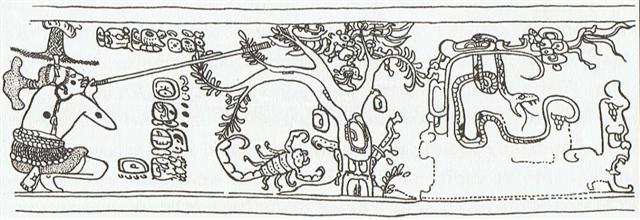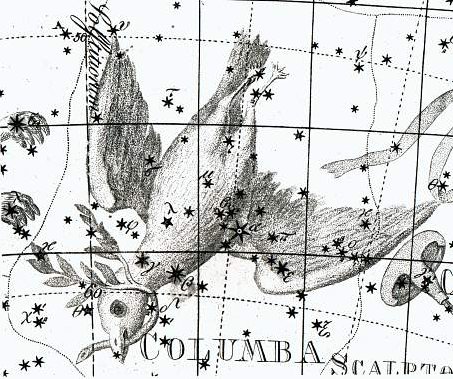5. In ancient times sinews were the strings which kept things together. I am thinking for instance about those of Tuna: ... Said Maui, 'What kind of combat do you wish?' Said Tuna, 'One of us enters into the body of the other, goes completely in. When it is over I will kill you, and take the woman back to my land.' So Maui agreed, and Tuna said, 'I will try it first.' He began his chanting: Hiki tautau orea, / Tautau orea, / He tangata nui i whano mai / I tena motu ra ... It is I, Tuna, / That now enters your body, O Maui! With this word Tuna went completely into Maui's body, he went through the place for entering and disappeared. After a while he came out again. Said Maui, 'Now it is my turn,' and he spoke a chant like that which Tuna said: Ko vau, ko Maui, e tomo ki roto / I ia a u, e Te Tuna! With this word Maui entered into Tuna's body, and all of Tuna's sinews came apart, he died. South of the equator Tuna - representing the dark back side of the year - would surely come apart around spring equinox (September 22), but possibly some of the tellers of myth could have kept the effects of precession aside and pointed at the region of Scorpio, to Antares. North of the equator we have pictorial evidence worthy of notice:  Here we can see all the limbs of the Scorpion, to the left of the Tree. To the right a Serpent clings to the branch of some other tree, its mouth fully open and with the tip of its tail designed to indicate rain clouds. A similar such formation is further to the right and (3 + 2 + 1) + (2 + 2 + 1) = 11. This 'Flying Snake' presumably corresponds to Quetzalcoatl, the Feathered Serpent, a personificaction of Summer Sun. The seasons are opposite on the other side of the equator and the 'adversary' of Maui seems in the land of the Mayas to have been the Lord Giver of Bread. In the top of the central Tree the ruling bird has 'alighted'. It should be the Lord Bringer of Spoils (Anax). According to Manuscript E the arrival of King Sun coincides with Anakena, both the beautiful beach and the month: ... When Hotu's canoe had reached Taharoa, the vaginal fluid (of Hotu's pregnant wife) appeared. They sailed towards Hanga Hoonu, where the mucus (kovare seems to refer to the amniotic sac in this case) appeared. They sailed on and came to Rangi Meamea, where the amniotic fluid ran out and the conctractions began. They anchored the canoe in the front part of the bay, in Hanga Rau. The canoe of Ava Rei Pua also arrived and anchoraged. After Hotu's canoe had anchoraged, the child of Vakai and Hotu appeared. It was Tuu Maheke, son of Hotu, a boy. After the canoe of Ava Rei Pua had also arrived and anchoraged, the child of Ava Rei Pua was born. It was a girl named Ava Rei Pua Poki ... Hotu and Ava Rei Pua arrive together. In King Cepheus (the dark king of Ethiopia and father of Andromeda) the Mayan picture above was presented with the following comments:
Possibly Itzam-Yeh was a name for the Eagle of Lyra, the constellation with a beautiful shining 'tooth' in form of Vega, positioned close to winter solstice north of the equator. South of the equator there should for symmetry's sake be another bird falling down (opposite in character to that of an eagle), and indeed we have it, rising heliacally close to winter solstice south of the equator:
... So Maui picked some more berries, and this time he threw them down quite hard, and they hit both the father and the mother and actually hurt them a little. Then everyone got up and walked round peering into the branches of the tree. The pigeon cooed, and everyone saw it. Some went away and gathered stones, and all of them, chiefs and common people alike, began throwing stones up into the branches. They threw for a long time without hitting the pigeon once, but then a stone that was thrown by Maui's father struck him. It was Maui, of course, who decided that it should, for unless he had wished it, no stone could have struck him. It caught his left leg, and down he fell, fluttering through the branches to the ground. But when they ran to pick the bird up, it had turned into the shape of a young man ... (Cfr at Museida and Talitha.) |

